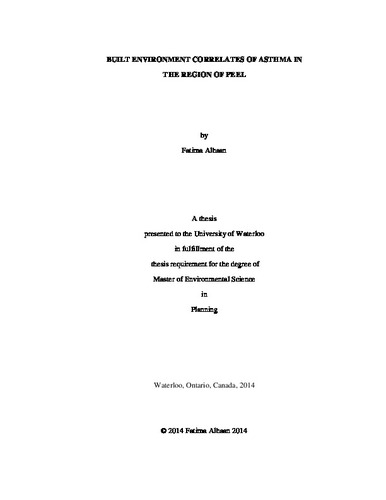| dc.description.abstract | Asthma is one of the most common respiratory illnesses. In Canada, about 3 million people suffer from chronic asthma. Studies have demonstrated association of asthma with built environment, socio-economic, and environmental factors. Land use planning can play an important role in shaping the built environment and consequently decrease asthma incidence. This research investigates the relationship of asthma outcome and its key determinants: built environment, socio-economic, and environmental factors in the Region of Peel between 2007 and 2011, and reviews the existing planning provisions concerning the disease. The primary research question that was addressed in this study is “what is the asthma pattern in the Region of Peel and what are the probable factors affecting it?” In order to address the research question, three sub questions were devised: 1) what is the pattern of asthma over space and time in the Region of Peel?; 2) what are the relevant factors that may explain asthma patterns?; and 3) what are the relevant policies that shape these factors?
A retrospective, quantitative approach was taken to address the questions using secondary data from open sources. To assess the spatiotemporal patterns, Geographic Information System (GIS) and descriptive statistics were used. The relationships between asthma and its key determinants were evaluated using correlation analysis. The policies concerning asthma and land use planning were also reviewed.
The research showed decreasing trends in asthma between 2007 and 2011 by 7.2%. The correlation analysis showed moderate relationships between asthma outcomes and average annual daily traffic, industrial emission, percentage of population using vehicles, percentage of population using transit, population at risk, prevalent low income population, and educated population. The study demonstrated importance of asthma awareness programs to ensure improved health in the Region of Peel. In addition, the importance of accessible health care facilities to reduce asthma outcome has been realized. Moreover, the study revealed that proper land use planning can result in improved health outcomes.
However, data was a limiting factor for this research. The data used were at aggregate levels and more observations could have increased accuracy of the study. Nevertheless, this study is the first of its kind as it attempts to investigate asthma outcomes in the built environment with explicit policy review at a regional scale | en |

